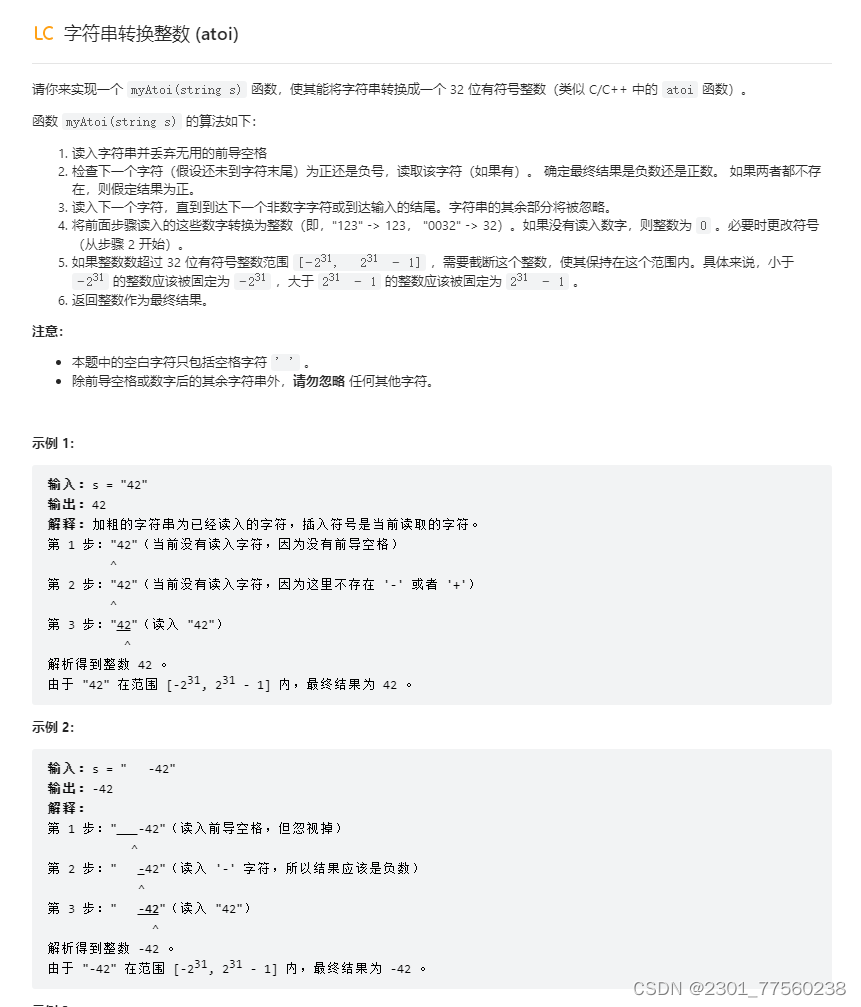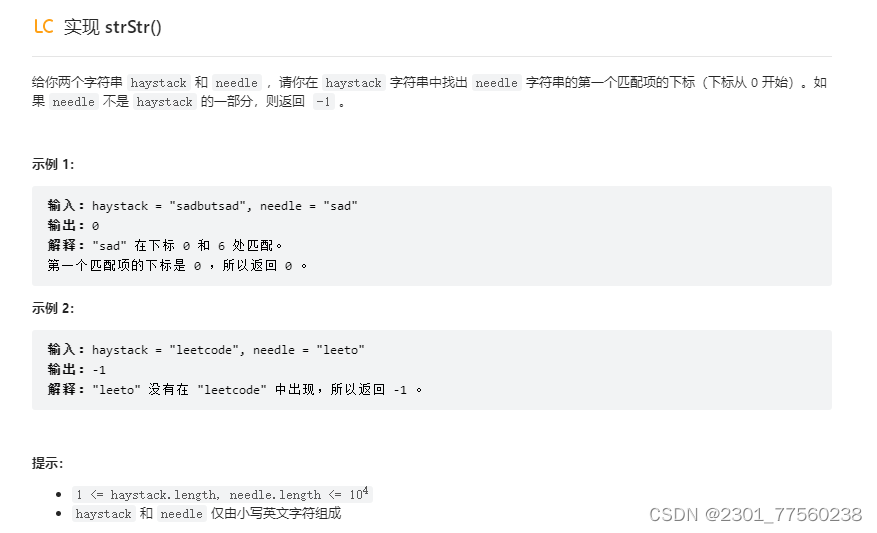提示:这篇文章主要是总结一些初级算法。意识到无数的刷题可能会增加算法能力,但是会需要很长的时间,这个初始算法就像是公式,在算法题中能够套用。虽然不知道是否可以达到这种效果,但是有一点,如果连初级算法都不会,那么算法题会很难做吧。
前言
可以一点点的整理,增加。
提示:以下是本篇文章正文内容,下面案例可供参考
一、二分查找法
这个是个很基础的算法了,之前做了会做,现在再做一次(2023年6月1日14:31:59)发现还是做错了,把错题一并整理在这。
1、数组查找
void binaryAlgorithmWrong()
{
int targetNum = 0;
while(scanf("%d",&targetNum) != NULL)
{
int array[10] = {63,2,6,24,19,34,22,9,45,11};
qsort(array, 10, sizeof(int), compare);
int slow = 0;
int fast = 10;
while(slow + 1 < fast)
{
int index = (fast + slow) / 2;
if(array[index] < targetNum)
{
slow = index;
}
else if(array[index] > targetNum)
{
fast = index;
}
else if(array[index] == targetNum)
{
printf("%d\n",index);
return;
}
}
printf("not exist\n");
return;
}
return;
}
int main()
{
binaryAlgorithm();
cout << "Hello world!" << endl;
return 0;
}正确示例:
//输入目标数,如果该数在数组中,返回下标,如果不在,返回not exist
void binaryAlgorithm()
{
int targetNum = 0;
while(scanf("%d",&targetNum) != NULL)
{
int array[10] = {63,2,6,24,19,34,22,9,45,11};
qsort(array, 10, sizeof(int), compare);
int slow = 0;
int fast = 9;
while(slow <= fast)
{
int index = (fast + slow) / 2;
if(array[index] < targetNum)
{
slow = index + 1;
}
else if(array[index] > targetNum)
{
fast = index - 1;
}
else if(array[index] == targetNum)
{
printf("%d\n",index);
return;
}
}
printf("not exist\n");
return;
}
return;
}
int main()
{
binaryAlgorithm();
cout << "Hello world!" << endl;
return 0;
}为什么第一种方法是无法得到正确的结果,想了一下,应该是不进行+1时,有的元素不能被访问到。比如如果targetNum是array[0],则最后都得不到正确的结果。+1时保证了元素每次都是更新的,被剔掉的元素正是此次判断不等于targerNum的元素,所以不会引入bug。
二、交换数值
1.反转字符串
反面示例:
//正确代码
void reverseString(char* s, int sSize){
int slow = 0;
for(int i = slow; i < sSize / 2; i++)
{
char temp = s[i];
s[i] = s[sSize - i - 1];
s[sSize - i - 1] = temp;
}
}
//反面代码
void reverseString(char* s, int sSize){
int slow = 0;
for(int i = slow; i < sSize / 2; i++)
{
char temp = s[slow ];
s[i] = s[sSize - slow - 1];
s[sSize - slow - 1] = temp;
}
}
//竟然还会范这个错误,一直调试都没发现问题,还在怀疑是不是因为数组穿指针没有改变数据。。。
//很低级的错误,记录一下2.翻转整数
先看题目:
整数反转
给你一个 32 位的有符号整数 x ,返回将 x 中的数字部分反转后的结果。如果反转后整数超过 32 位的有符号整数的范围 [−231, 231 − 1] ,就返回 0。
假设环境不允许存储 64 位整数(有符号或无符号)。
示例 1:
输入:x = 123
输出:321
示例 2:输入:x = -123
输出:-321
示例 3:输入:x = 120
输出:21
示例 4:输入:x = 0
输出:0
提示:
-231 <= x <= 231 - 1
代码如下
// int reverse(int x){
// int xcopy = x;
// int count = 0;
// while(xcopy)
// {
// xcopy /= 10;
// count++;
// }
// char *charx = (char*)malloc(count+1);
// // memset(charx, '\0', count+1);
// if(charx == NULL)
// {
// return 0;
// }
// sprintf(charx, "%d", x);
// int len = strlen(charx);
// int slow = 0;
// for(int i = 0; i < len / 2; i++)
// {
// char temp = charx[i];
// charx[i] = charx[len - i - 1];
// charx[len - i - 1] = temp;
// }
// int num = atoi(charx);
// if(num > pow(2,31) - 1 || num < -pow(2,31))
// {
// return 0;
// }
// return num;
// }
int reverse(int x){
long num = 0;
while(x)
{
int i = x % 10;
x = x / 10;
num = num * 10 + i;
}
if(num != (int)num)
{
return 0;
}
return num;
}高下立判!!

3、验证回文串
这个题目一共花了两次时间做好。第一次做的代码即代码块中的注释代码,做好代码提交代码的时候报了好几次未过。先后是"a."、",."、"0P"。一直根据未过信息修改代码,前前后后改了好几次,最后在"0P"时彻底卡死了,代码改的也烦了,就放弃了。觉得自己没有整理好逻辑和算法。第二次做的时候,就彻底理清了思路,想好算法逻辑,简单修改一次就Ace了。代码如下:
// bool isPalindrome(char * s){
// int len = strlen(s);
// int head = 0;
// int rear = len - 1;
// while(head < rear)
// {
// if( isalpha(s[head]) )
// {
// if(s[head] - s[rear] != 0 && abs(s[head] - s[rear]) != 32)
// {
// return false;
// }
// head++;
// rear--;
// }
// if( isdigit(s[head]) )
// {
// if( s[head] != s[rear] )
// {
// return false;
// }
// head++;
// rear--;
// }
// if(!isalpha(s[head]))
// {
// while(!isalpha(s[head]))
// {
// head++;
// if(head > len)
// {
// break;
// }
// }
// }
// if(!isalpha(s[rear]))
// {
// while(!isalpha(s[rear]))
// {
// rear--;
// if(rear < 0)
// {
// break;
// }
// }
// }
// }
// return true;
// }
bool IsAlphaOrDigital(char cha)
{
if(isalpha(cha) || isdigit(cha))
{
return true;
}
return false;
}
bool isPalindrome(char * s){
int len = strlen(s);
int head = 0;
int rear = len - 1;
while(head < rear)
{
if(IsAlphaOrDigital(s[head]) && IsAlphaOrDigital(s[rear]))
{
if(isalpha(s[head]))
{
if( s[head] == s[rear] || abs(s[head] - s[rear]) == 32 )
{
head++;
rear--;
continue;
}
return false;
}
else if(isdigit(s[head]))
{
if( s[head] == s[rear] )
{
head++;
rear--;
continue;
}
return false;
}
}
if( !IsAlphaOrDigital(s[head]) )
{
while(!IsAlphaOrDigital(s[head]) && head < len)
{
head++;
}
}
if( !IsAlphaOrDigital(s[rear]))
{
while(!IsAlphaOrDigital(s[rear]) && rear > 0)
{
rear--;
}
}
}
return true;
}
4、实现atoi

void findCharacterIndex(char* s, int* i)
{
while(s[*i] == ' ')
{
(*i)++;
}
}
bool isSubCharacter(char* s, int* i)
{
if(s[*i] == '+')
{
(*i)++;
return false;
}
else if(s[*i] == '-')
{
(*i)++;
return true;
}
return false;
}
int myAtoi(char * s){
int len = strlen(s);
int index = 0;
findCharacterIndex(s, &index);
bool isSub = isSubCharacter(s, &index);
long num = 0;
while(isdigit(s[index]))
{
if(num > LONG_MAX / 10 - 9)
{
break;
}
num = num * 10 + s[index] - '0';
index++;
}
if(num != (int)num)
{
num = isSub ? INT_MAX + 1 : INT_MAX;
}
return isSub ? (0 - num) : num;
}
这个题目是做的第一次就Ace的。这个题目中有两个坑,一个就是*i++,这样写是错的,要改成(*i)++;
第二个就是
if(num > LONG_MAX / 10 - 9)
{
break;
}
不然会long型数组溢出,leetcode会检查出来,其他编译器可就不会提示了。
这边昨天想了一下,可以优化一下代码性能,改成
if(num > INT_MAX)
{
break;
}

根据提交结果,效率确实提升了很多!
5、实现strstr()

int strStr(char * haystack, char * needle){
int len1 = strlen(haystack);
int len2 = strlen(needle);
for(int i = 0; i < len1; i++)
{
int index = 0;
int j = i;
while(haystack[j] == needle[index] && j < len1)
{
j++;
index++;
}
if(index == len2)
{
return i;
}
}
return -1;
}提交结果

这个题目一次Ace, 而且执行时间竟然是0秒,太牛了,怎么会这么牛逼?!
三、链表
1、删除链表的倒数第几个节点
/**
* Definition for singly-linked list.
* struct ListNode {
* int val;
* struct ListNode *next;
* };
*/
struct ListNode* removeNthFromEnd(struct ListNode* head, int n){
int count = 0;
struct ListNode *node = head;
while(node)
{
count++;
node = node->next;
}
if(count == 1)
{
return head->next;
}
if(n == 1)
{
struct ListNode *temp0 = head;
while(temp0)
{
if(temp0->next->next == NULL)
{
// temp0->val = temp0->next->val;
temp0->next = NULL;
}
temp0 = temp0->next;
}
return head;
}
int index = count - n;
if(index == 0)
{
head = head->next;
return head;
}
struct ListNode *temp = head;
int counter = 0;
while(temp)
{
counter++;
if(index == counter)
{
// int data = temp->next->next->val;
temp->next = temp->next->next;
// temp->next->val = data;
break;
}
temp = temp->next;
}
return head;
}这就是屎山代码吧。。。
2、自己写的链表
2023年6月8日14:33:48
这次写的链表只含有创建链表和打印链表
#include <iostream>
#include <stdio.h>
#include <stdlib.h>
using namespace std;
struct LianBiao
{
int data;
struct LianBiao *next;
};
struct LianBiao creatList(struct LianBiao* head, int len)
{
struct LianBiao* temp = head;
for(int i = 0; i < len; i++)
{
struct LianBiao* node = (struct LianBiao*)malloc(sizeof(struct LianBiao) * 1);
node->data = i * 2;
node->next = NULL;
temp->next = node;
temp = temp->next;
}
//free();
};
struct LianBiao creatList2(struct LianBiao* head, int len)
{
struct LianBiao* temp = head;
for(int i = 0; i < len; i++)
{
struct LianBiao* node = (struct LianBiao*)malloc(sizeof(struct LianBiao) * 1);
node->data = i * 2;
node->next = NULL;
temp->next = node;
}
//free();
};
struct LianBiao* creatList3(int len)
{
struct LianBiao* head = NULL;
struct LianBiao* temp = NULL;
for(int i = 0; i < len; i++)
{
struct LianBiao* node = (struct LianBiao*)malloc(sizeof(struct LianBiao) * 1);
node->data = i * 2;
node->next = NULL;
if(i == 0)
{
head = node;
temp = node;
}
else
{
temp->next = node;
temp = temp->next;
}
}
return head;
};
void printLianBiao(struct LianBiao* head)
{
while(head)
{
int data = head->data;
printf("%d ",data);
head = head->next;
}
}
int mainF()
{
struct LianBiao* head = (struct LianBiao*)malloc(sizeof(struct LianBiao) * 1);
creatList(head, 5);
printLianBiao(head);
cout << "Hello world!" << endl;
return 0;
}
int main()
{
struct LianBiao* head = creatList3(5);
printLianBiao(head);
cout << "Hello world!" << endl;
return 0;
}
//0 2 4 6 8 Hello world!关于链表,别人的博客详细说明:数据结构之——链表_链表数据结构_叶花永不相见的博客-CSDN博客
四、其他
3.颠倒二进制位
uint32_t reverseBits(uint32_t n) {
char array[33] = {'\0'};
int index = 31;
for(int i = 0; i < 32; i++)
{
if(n & 0x01)
{
array[index--] = '1';
}
else
{
array[index--] = '0';
}
n = n >> 1;
}
// int dat = atoi(array); //只能转十进制
unsigned int dat = 0;
for(int i = 31; i >= 0; i--)
{
if(array[i] == '1')
{
dat += (unsigned int)(pow(2, i) + 0.5);
}
}
return dat;
}一开始想用atoi实现的,发现不行,自己就写了下半段实现方法。其中还出了其实应该是等于'1',但是是等于1的bug。
该处使用的url网络请求的数据。
总结
提示:这里对文章进行总结:
例如:以上就是今天要讲的内容,本文仅仅简单介绍了pandas的使用,而pandas提供了大量能使我们快速便捷地处理数据的函数和方法。
























 163
163











 被折叠的 条评论
为什么被折叠?
被折叠的 条评论
为什么被折叠?








